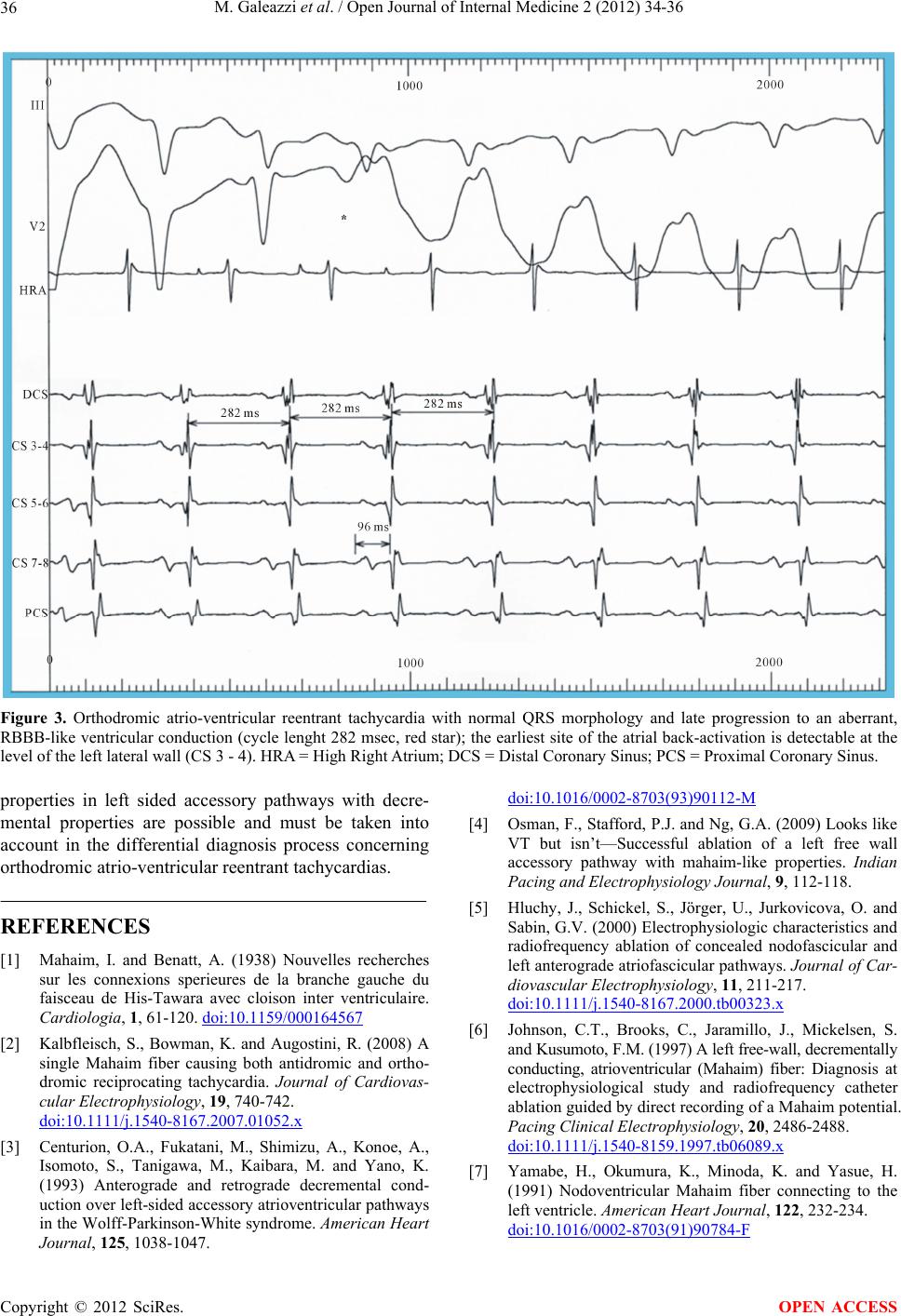
M. Galeazzi et al. / Open Journal of Internal Medicine 2 (2012) 34-36
36
Figure 3. Orthodromic atrio-ventricular reentrant tachycardia with normal QRS morphology and late progression to an aberrant,
RBBB-like ventricular conduction (cycle lenght 282 msec, red star); the earliest site of the atrial back-activation is detectable at the
level of the left lateral wall (CS 3 - 4). HRA = High Right Atrium; DCS = Distal Coronary Sinus; PCS = Proximal Coronary Sinus.
properties in left sided accessory pathways with decre-
mental properties are possible and must be taken into
account in the differential diagnosis process concerning
orthodromic atrio-ventricular reentrant tachycard ias.
REFERENCES
[1] Mahaim, I. and Benatt, A. (1938) Nouvelles recherches
sur les connexions sperieures de la branche gauche du
faisceau de His-Tawara avec cloison inter ventriculaire.
Cardiologia, 1, 61-120. doi:10.1159/000164567
[2] Kalbfleisch, S., Bowman, K. and Augostini, R. (2008) A
single Mahaim fiber causing both antidromic and ortho-
dromic reciprocating tachycardia. Journal of Cardiovas-
cular Electrophysiology, 19, 740-742.
doi:10.1111/j.1540-8167.2007.01052.x
[3] Centurion, O.A., Fukatani, M., Shimizu, A., Konoe, A.,
Isomoto, S., Tanigawa, M., Kaibara, M. and Yano, K.
(1993) Anterograde and retrograde decremental cond-
uction over left-sided accessory atrioventricular pathways
in the Wolff-Parkinson-White syndrome. American Heart
Journal, 125, 1038-1047.
doi:10.1016/0002-8703(93)90112-M
[4] Osman, F., Stafford, P.J. and Ng, G.A. (2009) Looks like
VT but isn’t—Successful ablation of a left free wall
accessory pathway with mahaim-like properties. Indian
Pacing and Electrophysiology Journal, 9, 112-118.
[5] Hluchy, J., Schickel, S., Jörger, U., Jurkovicova, O. and
Sabin, G.V. (2000) Electrophysiologic characteristics and
radiofrequency ablation of concealed nodofascicular and
left anterograde atriofascicular pathways. Journal of Car-
diovascular Electrophysiology, 11, 211-217.
doi:10.1111/j.1540-8167.2000.tb00323.x
[6] Johnson, C.T., Brooks, C., Jaramillo, J., Mickelsen, S.
and Kusumoto, F.M. (1997) A left free-wall, decrementally
conducting, atrioventricular (Mahaim) fiber: Diagnosis at
electrophysiological study and radiofrequency catheter
ablation guided by direct recording of a Mahaim potential.
Pacing Clinical Electrophysiology, 20, 2486-2488.
doi:10.1111/j.1540-8159.1997.tb06089.x
[7] Yamabe, H., Okumura, K., Minoda, K. and Yasue, H.
(1991) Nodoventricular Mahaim fiber connecting to the
left ventricle. American Heart Journal, 122, 232-234.
doi:10.1016/0002-8703(91)90784-F
Copyright © 2012 SciRes. OPEN ACCESS